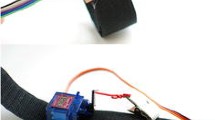Abstract
Human Pacman is a novel interactive entertainment system that ventures to embed the natural physical world seamlessly with a fantasy virtual playground by capitalizing on mobile computing, wireless LAN, ubiquitous computing, and motion-tracking technologies. Our human Pacman research is a physical role-playing augmented-reality computer fantasy together with real human–social and mobile gaming. It emphasizes collaboration and competition between players in a wide outdoor physical area which allows natural wide-area human–physical movements. Pacmen and Ghosts are now real human players in the real world, experiencing mixed computer graphics fantasy–reality provided by using the wearable computers. Virtual cookies and actual tangible physical objects are incorporated into the game play to provide novel experiences of seamless transitions between real and virtual worlds. We believe human Pacman is pioneering a new form of gaming that anchors on physicality, mobility, social interaction, and ubiquitous computing.













Similar content being viewed by others
Notes
Videos introducing human Pacman are available online at http://mixedreality.nus.edu.sg/research-HP-videos.htm .
References
Zhang Z, Shan Y (2001) State of the industry report. Entertainment Software Association report 2000–2001. Available at: http://www.theesa.com/pressroom.html. Cited 2001
Essential facts about the computer and video game industry. Entertainment Software Association (2002). Available at: http://www.theesa.com/pressroom.html. Cited 2002
Crawford C (1998) Live: What a concept!... Networked games. In: Dodsworth C Jr (ed) Digital illusion. ACM Press, New York, pp 241–248
Bowlby J (1983) Attachment and Loss, vol 1. Attachment Basic Books, New York
Björk S, Falk J, Hansson R, Nakao K, Ljungstrand P (2001) Pirates—using the physical world as a game board. In: Proceedings of Interact 2001 IFIP TC. 13 conference on human–computer interaction, Tokyo, Japan, July 2001
Mandryk RL, Inkpen KM (2001) Supporting free play in ubiquitous computer games. In: Workshop on designing ubiquitous computer games. UbiComp 2001, Atlanta, Georgia
Equator CityWide Performance (2003) Available at: http://www.equator.ac.uk. Cited 2003
Konami Corporation ParaParaParadise (2001) Available at: http://www.konami.com.hk/kma_ac/ac_ppp/ppp.html. Cited 2001
Oshima T, Satoh K, Yamamoto H, Tamura H (1998) AR2 hockey system: a collaboration mixed reality system. Trans VRSJ 3(2):55–60
Tamura H, Yamamoto H, Katayama A (2001) Mixed reality: future dreams seen at the border between real and virtual worlds. Comput Graph Appl 21(6):64–70
Starner T et al (1997) Augmented reality through wearable computing. Presence 6(4):386–398
Thomas B, Close B, Donoghue J, Squires J, Bondi PD, Piekarski W (2002) First person indoor\outdoor augmented reality application: ARQuake. Pers Ubiquit Comput 6(1):75–86
Author information
Authors and Affiliations
Corresponding author
Rights and permissions
About this article
Cite this article
Cheok, A.D., Goh, K.H., Liu, W. et al. Human Pacman: a mobile, wide-area entertainment system based on physical, social, and ubiquitous computing. Pers Ubiquit Comput 8, 71–81 (2004). https://doi.org/10.1007/s00779-004-0267-x
Received:
Accepted:
Published:
Issue Date:
DOI: https://doi.org/10.1007/s00779-004-0267-x




